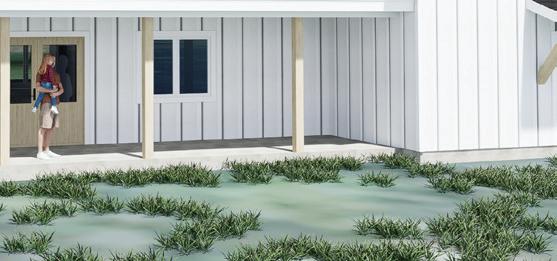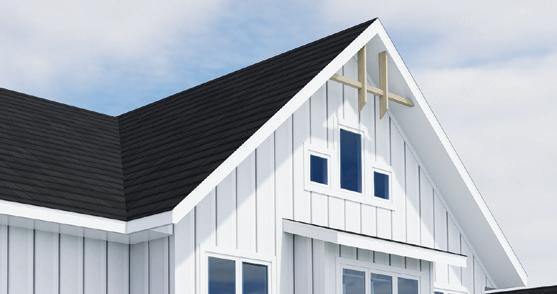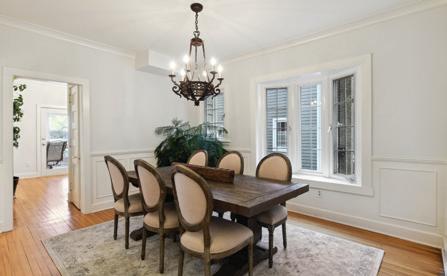
7 minute read
PORTRAIT City Roots
By Daniel Huss
CONSIDER THE FACTS: It’s estimated that more than 40 million American elm trees, which once lined many a boulevard, have been killed by Dutch elm disease. In Minnesota, one in every five trees is an ash tree. All totaled, the state is said to have an ash population of over a billion, and the emerald ash borer has put every one of those trees at risk. Note: The Asian long horned beetle looms as the next invasive troublemaker. It feasts on hardwoods like maple and birch.
If those infestations weren’t reason enough for cities to hire arborists, they could be or maybe should be. Meet certified arborist Bennett Myhran, the City of Wayzata’s forester. He’s tasked with monitoring and planning the city’s tree population and the ornamental, perennial and annual gardens and answering treeand plant-related questions coming from residents, developers (Wayzata recently passed a tree ordinance) and city staff.
Myhran has a lot of ground to cover, if you will, since Wayzata’s tree canopy cover stands at nearly 30 percent of its surface area. (The goal is 4 percent.)

By comparison, Minneapolis’ tree canopy stands at only 4 percent.
The diversity of the canopy is important, and it’s reason number one why Wayzata is conducting a tree survey.
“We want to understand how diverse our tree population is,” Myhran says. This information, in turn, will be used as the city replants its tree population. “The goal is to not have one genus of tree represent more than 20 percent of the population,” he says.
In its current state, Wayzata’s tree population numbers skew toward maples and oaks.
For future growth, what types of trees are the city planting? It depends. If it’s on a boulevard, where soil can be compact and there are sidewalks to be considered, Myhran says he likes shag bark hickory and ginkgoes. “Hickory roots don’t heave,” he says. “The ginkgo is also a good option. They’re a fossil species, meaning they’ve been around for millions of years. They’re slower growing, but slower growing equates to toughness.”
On a side note, Myhran considers the ginkgo as one of his personal favorites. “They’re goofy,” he says. “They show off a funky color. They’re not really deciduous, and they’re not coniferous. They’re kind of their own species.” His least favorite? It’s likely the same for a lot of homeowners—buckthorn. (Visit lakeminnetonka mag.com for the October 2022 issue in which we examine ways to battle, yes battle, this invasive neighbor.)
For homeowners set to plant trees, Myhran says one of the biggest missteps people take is placing or planting the root ball too deep in the ground. (The first level of roots should be near the surface.) An even bigger offense is failing to adequately water trees. “Well-watered trees have less issues,” he says. “It’s that simple.” Lastly, Myhran recommends trimming trees over winter. “Pests and pathogens are typically dormant,” he says. “You can see the tree’s structure, and it’s not nearly as messy.”
Trees have tangible benefits. Varieties of certain sizes on private property, for example, can increase property values. Trees pull carbon dioxide out of the air, have water table benefits (filtration), can slow storm surges and act as shade providers, which offers a natural way of cooling one’s home.



Bottom line, one of the reasons it’s important to care for city or residentowned trees is, well, the bottom line. “Trees are an investment,” Myhran says. bmyhran@wayzata.org;







Archives
Mystery Solved Youth makes an interesting discovery on Big Island.
By Mollee Francisco
WALKING THE BEACH at Big Island on Lake Minnetonka, one never knows what strange object might catch his/ her eye. “There’s still a lot of debris from when it was an amusement park,” Jillian McGary says. The Deephaven resident and her 11-year-old son, Lucas, were taking their dog, Halo, for a walk last August when their search for cool rocks turned up something that was neither a rock nor amusement park debris. “I thought it was petrified wood,” Lucas says. “Mom thought it was a tooth.”
Whatever the roughly 2-1/2-inchlong object was, Lucas knew he wanted to bring it back home to study it. Once home, they began to wonder if they had unearthed a dinosaur fossil. “In my brain, it’s a fossil, so it must be a dinosaur,” McGary says. “There’s not much of a dinosaur fossil record in Minnesota.”

After an exhaustive internet search, they were no closer to finding a definitive answer, so McGary reached out to the experts. “I wrote to two paleontologists,” she says. Alex Hastings, Ph.D., the Fitzpatrick Chair of Paleontology at the Science Museum of Minnesota in St. Paul, was on the receiving end of one of those emails. From the pictures, he agreed that it was an odd piece. He invited the McGary family to the museum to go through its osteology collection (part of the Biology Department) to help identify piece. “It’s always easier to identify in person,” Hastings says. “We’ve done this a couple of times and used it as an educational opportunity.”
The McGary family accepted the invitation and spent an hour in the bone room with Hastings. “I walked them through our process and showed them our collection,” Hastings says. And after examining their find, Hastings was able

156 Lake Street, Excelsior, MN 55331 to determine that it was likely part of a juvenile bison skull—the horn, where it meets the rest of the skull, which has a characteristic ridge that helped identify it. “We went through the whole process,” Hastings says. “The canals helped narrow it down.”
Hastings estimated that the fossil was around 4,000–5,000 years old, based on other carbon-dated bison remains previously found in that area. “It’s a little rare,” he says. “You’re not likely to run into one every time you go to the beach.” Hastings says there was a time that bison would have been a regular sight around Lake Minnetonka. “They were incredibly abundant. There were massive herds across the landscape,” he says.
The McGary’s were excited to get some answers about the piece. “I find it delightful to be wrong,” McGary says. “We were able to learn so much.”
“It’s not as cool as a dinosaur, but, wow,” Lucas says. “We realized this goes back to the King Tut era.”
After their visit to the science museum, Lucas, a fifth grader at Deephaven Elementary School, wrote up a field report detailing the experience. He’s not ruling out a future career in paleontology. And, of course, they’ve been back to Big Island to see what else they could find. So far, no other petrified remains have turned up, but Lucas says they plan to keep looking. As for his bison fossil, Lucas says he’d be happy to donate it if asked. “Either that or it’s mine,” he says.
Science Museum of Minnesota, 120 W. Kellogg Blvd., St. Paul; 651.221.9444; smm.org
Visit lakeminnetonkamag.com to learn about #FossilFriday with Dr. Crocogator.
4 Bedroom / 4 Bath
3185 Finished Sq. Feet
$1,699,000.00
Unique and rare opportunity for park front, panoramic lake view property in the city of Excelsior. Turn of the century home loaded with vintage charm and sun filled spaces. Wood floors, high ceilings, wainscotting & crown molding add to the charm. Three generous bedrooms on the 2nd floor and a 3rd story loft currently enjoyed as a family room/o ce. Enjoy the location on the wrap around porch or firepit. Fantastic candidate for a remodel, addition, or build your dream home! Located on the shores of Lake Minnetonka, in historic Excelsior.


• Awarded top producer and established expert in the Lake Minnetonka community




• In-depth understanding of today’s market and trends
• Experience and creativity for all real estate needs
• Unmatched service and results
COLLECTORS’ CORNER
Do you have a cool find you would like help identifying? The Science Museum of Minnesota features a Collectors’ Corner, where the public is invited to bring in whatever they find in nature, and staff members will try to help identify it. The Collectors’ Corner is located near the lobby and is staffed during regular museum hours.
By Zoe Deal
THE PROCESS OF SHOPPING for new home furniture is no longer as straightforward as stepping into a furniture store. The internet holds hundreds of unique styles and price ranges, and social media offers its own take on furniture must-haves. But for some local furniture retailers, continued success comes from supporting the tradition of shopping in-person for heirloom furniture.
To learn some shopping strategies, we reached out to Borofka’s Furniture owner Jim Borofka and its visual merchandising manager Hannah Zaske. With three locations, including in Minnetonka, Borofka’s solid wood furniture inventory has driven its growth in nearly 30 years of business.
In a world increasingly committed to style over substance, how can consumers find and care for the perfect, lasting piece? Borofka and Zaske provide insight.
To test the quality of craftsmanship, Borofka’s longtime method is the twist test, where one puts his/her toe on one edge of a furniture piece (such as a chest), then lifts and twists from the top. “There’s some pieces that you’re like, ‘Whoa. I have to put it back. I’m going to twist it right into a pile,’” Borofka says. “That conveys to me whether they’re building it for just the look of it, or they’re building it to last.”
The joints in all furniture sold at Borofka’s are screwed, glued and doweled, which amounts to a well-mended piece that, when twisted, shouldn’t bend or buckle. That’s something buyers should consider, along with drawer construction (Watch for English dovetail and five-board drawer construction.) and hardware (Consider full-extension ballbearing glides for ease of use and longevity.), which all can be found at Borofka’s.
Borofka gets excited when he talks about the quality finishes Borofka’s featured builders blend and use on-site. “Our small builders, they use this better finish because they know if you work
Built To Last
Borofka and business partner Maynard Huth opened the first Borofka’s in 1993, full of what Borofka describes as “youthful optimism” and fresh out of the University of Wisconsin–Eau Claire. And while they initially tried to source from big box companies, they found their niche in working with small-time builders from around the Midwest. “It’s quality without the stuffiness,” Borofka says, “We’re farm kids … We’re just into the quality.”


Now, some 30 years later, Borofka’s approach has yet to change. The business works closely with 20 small, local builders, with their own specialties and styles, to stock its three Metro-area showrooms (Burnsville, Minnetonka and Woodbury). About 90 percent of its offerings are built within Minnesota, Indiana, Ohio and Wisconsin in a direct relationship with the craftsmen.

Wood Care
The team at Borofka’s offers cleaning tips:
• Remove dust with a damp cloth, wiping with the wood grain.
• To hide scratches and imperfections, use a touch-up marker or a bit of shoe polish or stain.
• Avoid cleaning furniture with acidbased cleaners and petroleum waxes, oily polishes and vinegar.
• Keep all chemicals, alcohol and plastic products away from the piece to keep the lacquer intact.
• Use trivets or pot holders to protect the surface if setting hot dishes on wood tops.
• Make sure to level the furniture, as houses can settle unevenly over time and warp doors on furnishings like armoires.
• To avoid cracking and warping, keep a home’s humidity between 40–45 percent.

